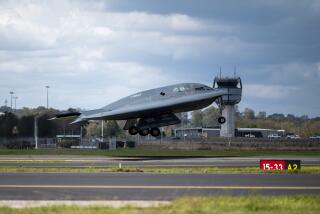Bomber’s Balky Wheel Forces Dusty Descent
- Share via
EDWARDS AIR FORCE BASE — A B-1B bomber made a dusty but safe emergency landing here on partly retracted landing gear Wednesday evening after the flight crew had struggled unsuccessfully for more than six hours to lower the plane’s nose wheel.
The Air Force said the bomber flew more than 1,000 miles to this Kern County base from Texas after the problem was discovered on a training flight. It made several preliminary low-level passes, including a brief “touch-and-go,” before making its final approach at about 6:15 p.m.
The big plane settled onto the long dirt runway on its two main landing gear, which were locked properly into position. The pilots stayed off the brakes to keep the nose up, and the plane rolled down the landing strip for almost three miles before nosing down gently on the retracted front gear and sliding to a stop.
“It’s been a great day for flying, except for a few glitches,” one of the pilots said seconds before the plane came to a halt and the dust cloud began to settle. The radioed remarks from the cockpit were monitored by a local aviation buff.
The supersonic bomber apparently suffered only “minimal” damage and no one on the crew was injured, officials said. Aboard were Capt. Jeffrey K. Beene, 30, the aircraft commander; Capt. Vernon B. Benton, 30, pilot; Capt. Robert H. Hendricks, 31, weapons officer, and Lt. Col. Joseph G. Day, 39, an instructor.
“They all look fine,” Air Force Lt. Col. Jan Dalby, chief of public affairs at Edwards, said later. “They’re glad to be down. They were up there over 12 hours.”
The officials said the B-1B was not armed with any of the nuclear bombs it is designed to carry.
They said the crew had some hydraulic problems during their three-hour training flight, and as they were coming in for a landing at Dyess Air Force Base, near Abilene, Tex., the front landing gear, which is operated hydraulically, failed to lower.
The plane was refueled twice by an airborne tanker as it circled for another four hours while experts discussed how to solve the problem. The bomber then made the three-hour flight to Edwards, circling over the base for another two hours before the landing was made.
Air Force officials said it was decided to land the plane on Rogers Dry Lake at Edwards--the site of most of the Space Shuttle landings--because the smooth, six-mile, unpaved runway there is one of the safest spots to attempt an emergency touchdown.
They said the unpaved surface minimizes sparks that could touch off a fire, the length of the runway reduces the need for emergency braking, and Edwards is equipped with some of the best-trained emergency fire crews in the world.
The B-1B--147 feet long, with a wingspan of 137 feet and a laden weight of up to 477,000 pounds--was the centerpiece of the Reagan Administration’s $260-billion effort to modernize the nation’s strategic nuclear arsenal.
The swing-wing bomber was designed to fill the gap between the aging B-52 fleet and the new B-2 Stealth bomber.
Last March, the Air Force temporarily grounded all 97 of the $285-million B-1Bs because of problems with one of the movable wings on one of the planes at Dyess.
Officials said the grounding was ordered after a pilot found in a preflight check that he was unable to synchronize the movement back and forth of the plane’s adjustable wings. The officials later said the problem apparently was confined to the individual plane.
There have been four crashes involving B-1 bombers.
The first, which killed veteran Rockwell International test pilot T. D. (Doug) Benefield and injured two other members of the flight crew, involved a prototype on an Edwards-based, low-altitude test flight over the Mojave Desert on Aug. 29, 1984.
An Air Force investigative panel concluded that “human error”--failure by the cockpit crew to properly redistribute the fuel load--caused the plane to stall, veer out of control and plummet earthward. The crew ejected, suffering their injuries when a malfunction of the ejection mechanism caused the escape capsule to land at the wrong angle.
The second crash, and the first involving a production model B-1B, occurred Sept. 28, 1987, when a Dyess-based plane collided with a large bird--probably a pelican--on a test flight over southeastern Colorado. The “extremely rare” collision with the bird at 600 m.p.h. caused a fire that doomed the plane, Air Force investigators said.
Three crew members ejected safely before that crash but another died because his ejection seat malfunctioned. Two others were killed because they were sitting in jump seats that had no ejection devices, according to investigators.
The third crash, on Nov. 8, 1988, occurred when a B-1B suffered an engine fire and slammed into a cow pasture shortly after takeoff from Dyess. All four crew members ejected safely.
Nine days later, on Nov. 17, 1988, a B-1B clipped a power line on final approach to Ellsworth Air Force Base, near Rapid City, S.D., and fell into a field short of the runway. The four crewmen escaped with minor injuries.
More to Read
Sign up for Essential California
The most important California stories and recommendations in your inbox every morning.
You may occasionally receive promotional content from the Los Angeles Times.










